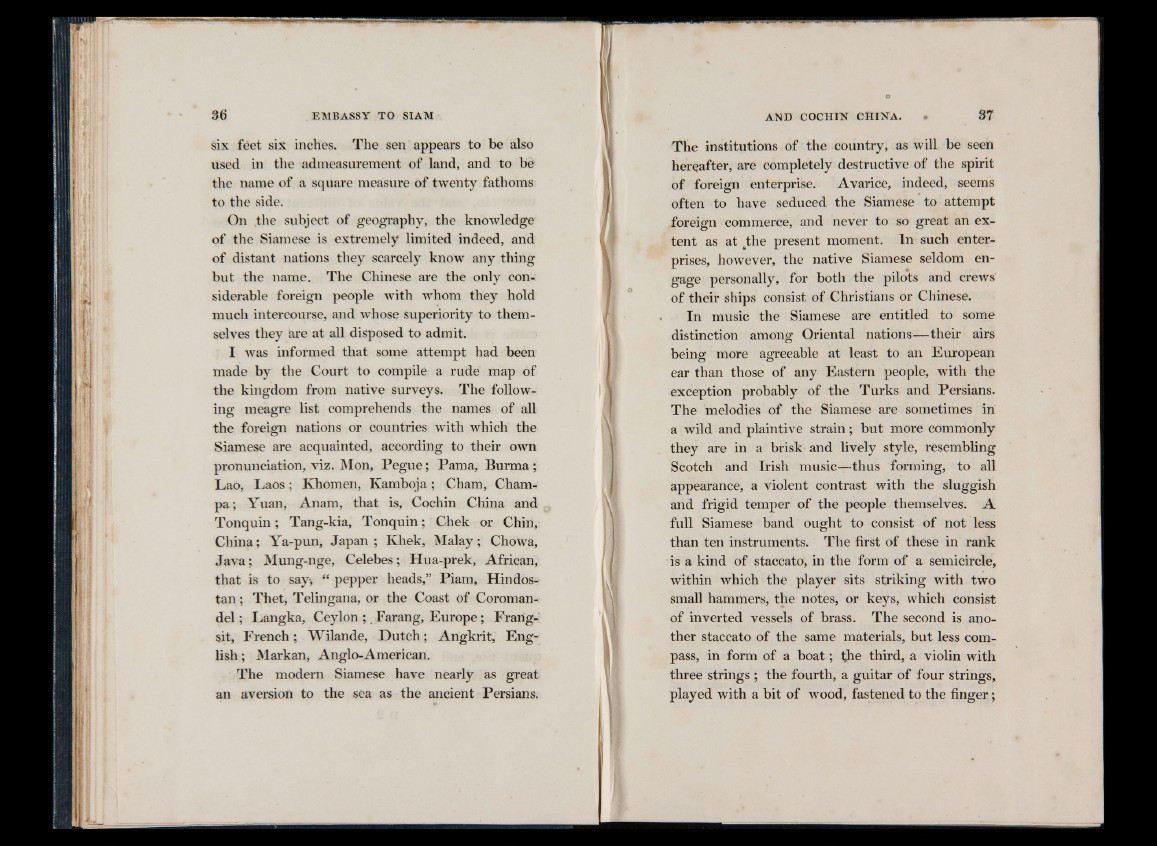
six feet six inches. The sen appears to be also
used in the admeasurement of land, and to be
the name of a square measure of twenty fathoms
to the side.
On the subject of geography, the knowledge
of the Siamese is extremely limited indeed, and
of distant nations they scarcely know any thing
but the name. The Chinese are the only considerable
foreign people with whom they hold
much intercourse, and whose superiority to themselves
they are at all disposed to admit.
I was informed that some attempt had been
made by the Court to compile a rude map of
the kingdom from native surveys. The following
meagre list comprehends the names of all
the foreign nations or countries with which the
Siamese are acquainted, according to their own
pronunciation, viz. Mon, P eg u e ; Pama, Burma ;
Lao, L ao s; Khomen, Kamboja; Cham, Champa;
Yuan, Anam, that is, Cochin China and
Tonquin; Tang-kia, Tonquin; Chek or Chin,
China; Ya-pun, Jap an ; Khek, Malay; Chowa,
J a v a ; Mung-nge, Celebes; Hua-prek, African,
that is to say-, “ pepper heads,” Piam, Hindostán
; Thet, Telingana, or the Coast of Coromandel
; Langka, Ceylon ; Farang, Europe; Frarig-
sit, F ren ch ; Wilande, D u tc h ; Angkrit, English;
Markan, Anglo-American.
The modern Siamese have nearly as great
an aversion to the sea as the ancient Persians.
The institutions of the country, as will be seen
hereafter, are completely destructive of the spirit
of foreign enterprise. Avarice, indeed, seems
often to have seduced the Siamese to attempt
foreign commerce, and never to so great an extent
as at .the present moment. In such enterprises,
however, the native Siamese seldom engage
personally, for both the pilots and crews
of their ships consist of Christians or Chinese.
In music the Siamese are entitled to some
distinction among Oriental nations—their airs
being more agreeable at least to an European
ear than those of any Eastern people, with the
exception probably of the Turks and Persians.
The melodies of the Siamese are sometimes in
a wild and plaintive strain; but more commonly
they are in a brisk and lively style, resembling
Scotch and Irish music—thus forming, to all
appearance, a violent contrast with the sluggish
and frigid temper of the people themselves. A
full Siamese band ought to consist of not less
than ten instruments. The first of these in rank
is a kind of staccato, in the form of a semicircle,
within which the player sits striking with two
small hammers, the notes, or keys, which consist
of inverted vessels of brass. The second is another
staccato of the same materials, but less compass,
in form of a b o a t; the third, a violin with
three strings ; the fourth, a guitar of four strings,
played with a bit of wood, fastened to the finger;